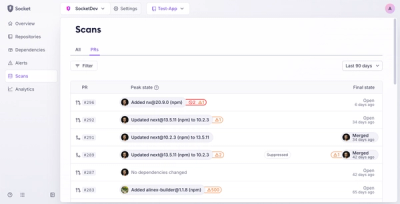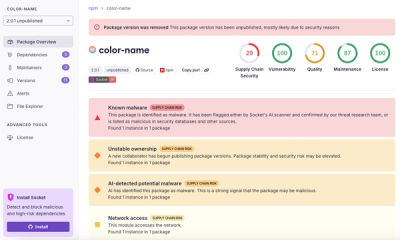
Product
Introducing Pull Request Stories to Help Security Teams Track Supply Chain Risks
Socket’s new Pull Request Stories give security teams clear visibility into dependency risks and outcomes across scanned pull requests.
Creates a link tag of the given name using a URL created by the set of options. Please see documentation for link_to, as active_link_to is basically a wrapper for it. This method accepts an optional :active parameter that dictates if the given link will have an extra css class attached that marks it as 'active'.
When installing for Rails 3/4/5 applications add this to the Gemfile: gem 'active_link_to' and run bundle install.
For older Rails apps add config.gem 'active_link_to' in config/environment.rb and run rake gems:install. Or just checkout this repo into /vendor/plugins directory.
Here's a link that will have a class attached if it happens to be rendered
on page with path /users or any child of that page, like /users/123
active_link_to 'Users', '/users'
# => <a href="/users" class="active">Users</a>
This is exactly the same as:
active_link_to 'Users', '/users', active: :inclusive
# => <a href="/users" class="active">Users</a>
Here's a list of available options that can be used as the :active value
* Boolean -> true | false
* Symbol -> :exclusive | :inclusive | :exact
* Regex -> /regex/
* Controller/Action Pair -> [[:controller], [:action_a, :action_b]]
* Controller/Specific Action Pair -> [controller: :action_a, controller_b: :action_b]
* Hash -> { param_a: 1, param_b: 2 }
Most of the functionality of active_link_to depends on the current
url. Specifically, request.original_fullpath value. We covered the basic example
already, so let's try something more fun.
We want to highlight a link that matches immediate url, but not the children nodes. Most commonly used for 'home' links.
# For URL: /users will be active
active_link_to 'Users', users_path, active: :exclusive
# => <a href="/users" class="active">Users</a>
# But for URL: /users/123 it will not be active
active_link_to 'Users', users_path, active: :exclusive
# => <a href="/users">Users</a>
If we need to set link to be active based on some regular expression, we can do that as well. Let's try to activate links urls of which begin with 'use':
active_link_to 'Users', users_path, active: /^\/use/
If we need to set link to be active based on an exact match, for example on filter made via a query string, we can do that as well:
active_link_to 'Users', users_path(role_eq: 'admin'), active: :exact
What if we need to mark link active for all URLs that match a particular controller, or action, or both? Or any number of those at the same time? Sure, why not:
# For matching multiple controllers and actions:
active_link_to 'User Edit', edit_user_path(@user), active: [['people', 'news'], ['show', 'edit']]
# For matching specific controllers and actions:
active_link_to 'User Edit', edit_user_path(@user), active: [people: :show, news: :edit]
# for matching all actions under given controllers:
active_link_to 'User Edit', edit_user_path(@user), active: [['people', 'news'], []]
# for matching all controllers for a particular action
active_link_to 'User Edit', edit_user_path(@user), active: [[], ['edit']]
Sometimes it should be as easy as giving link true or false value:
active_link_to 'Users', users_path, active: true
If we need to set link to be active based on params, we can do that as well:
active_link_to 'Admin users', users_path(role_eq: 'admin'), active: { role_eq: 'admin' }
You can specify active and inactive css classes for links:
active_link_to 'Users', users_path, class_active: 'enabled'
# => <a href="/users" class="enabled">Users</a>
active_link_to 'News', news_path, class_inactive: 'disabled'
# => <a href="/news" class="disabled">News</a>
Sometimes you want to replace link tag with a span if it's active:
active_link_to 'Users', users_path, active_disable: true
# => <span class="active">Users</span>
If you are constructing navigation menu it might be helpful to wrap links in another tag, like <li>:
active_link_to 'Users', users_path, wrap_tag: :li
# => <li class="active"><a href="/users">Users</a></li>
You can specify css classes for the wrap_tag:
active_link_to 'Users', users_path, wrap_tag: :li, wrap_class: 'nav-item'
# => <li class="nav-item active"><a href="/users">Users</a></li>
You may directly use methods that active_link_to relies on.
is_active_link? will return true or false based on the URL and value of the :active parameter:
is_active_link?(users_path, :inclusive)
# => true
active_link_to_class will return the css class:
active_link_to_class(users_path, active: :inclusive)
# => 'active'
Copyright (c) 2009-17 Oleg Khabarov. See LICENSE for details.
FAQs
Unknown package
We found that active_link_to demonstrated a not healthy version release cadence and project activity because the last version was released a year ago. It has 1 open source maintainer collaborating on the project.
Did you know?

Socket for GitHub automatically highlights issues in each pull request and monitors the health of all your open source dependencies. Discover the contents of your packages and block harmful activity before you install or update your dependencies.

Product
Socket’s new Pull Request Stories give security teams clear visibility into dependency risks and outcomes across scanned pull requests.

Research
/Security News
npm author Qix’s account was compromised, with malicious versions of popular packages like chalk-template, color-convert, and strip-ansi published.

Research
Four npm packages disguised as cryptographic tools steal developer credentials and send them to attacker-controlled Telegram infrastructure.